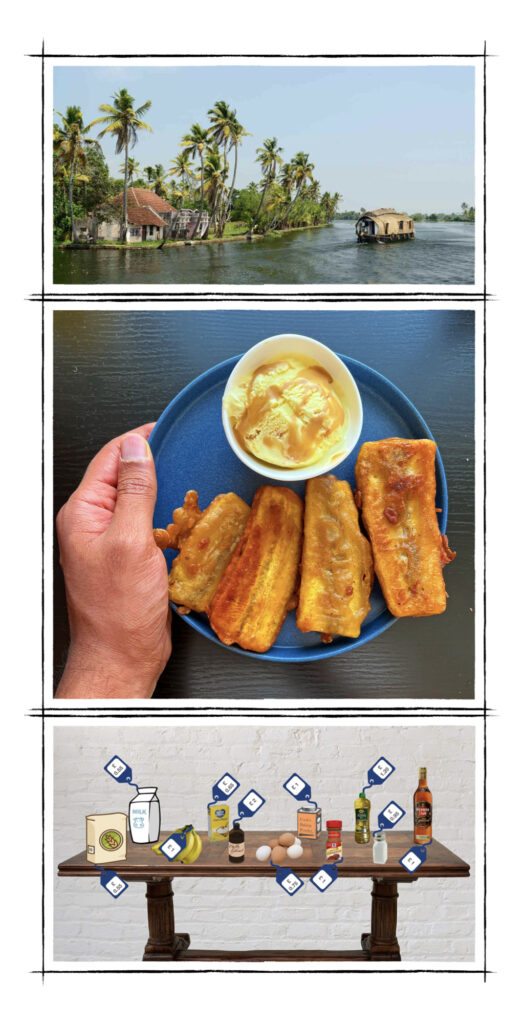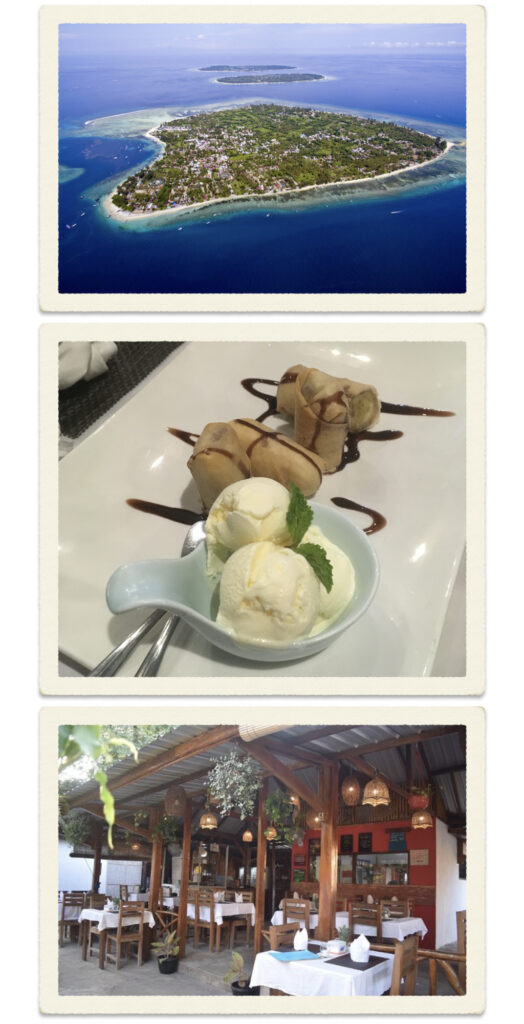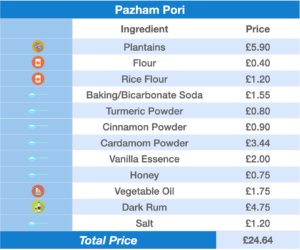Pazham Pori

What's In A Name
Country of Origin - India
Region - Kerala
It's raining, it's pouring, the old man is gazing out his window longing for some warm, comforting food that he can take out to the balcony, sit and enjoy.
Isn't that how the nursery rhyme goes?
During the monsoons, those in the North make samosas, those in the West make dhoklas, those in the East make momos, and those in the South make Pazham Poris.
The Pazham Pori, aka Vazhakkappam, aka Etakka Appam is a fritter made from ripened plantains, which are slit length-wise post-peeling, dipped in a thick batter made from flour, salt, turmeric powder, and sugar, and deep fried in oil until golden brown.
The Pazham Pori, which originates from Kerala, is one of the most popular South Indian breakfast meals/snacks/desserts (depends on the occasion), often found served along with a cup of tea or chai in the evenings.
The dish, however, is not exclusive to the state of Kerala. While the preparation and cooking processes may almost be exact, the dish has several aliases across neighbouring states and countries. For example, it is called Vazhakkay Bajji in Tamil Nadu, Balekayi Bajji in Karnataka, Pisang Goreng in Indonesia, Pritong Saging in the Philippines, and Kluai Khaek in Thailand.

Our Connection
എവിടെ (Where) - Ruby's Cafe, Gili Air, Indonesia
എപ്പോൾ (When) - June, 2019
Here I am talking about a South Indian dish when I'm sat here in the middle of an island off the coast of Indonesia.
While the inspiration for my Pazham Pori does not originate from Kerala or anywhere remotely close to the South of India, it is inspired by a similar dish - the Pisang Goreng from South-East Asia (predominantly Indonesia). Same-same but different, as they say!
A four hour snorkeling trip, which ended with a beautiful serene view of the sunset, left me not only extremely tired, but more importantly, exceptionally famished!
Fortunately, despite its relatively petite size, Gili Air possessed a plethora of dining options - from traditional Indonesian to European/American classics. Which posed a slight dilemma for us when choosing a restaurant for dinner. But when in Indonesia, dine like the Indonesians would, right? And just like that, we were sat at Ruby's Cafe.
The cafe - a homely remodeled villa - would have served as the perfect backdrop to Elizabeth Gilbert's Eat, Pray, and Love. As cute as the ambience was, the food was remarkable in every manner. Our main courses of Vegetable Green Curry and Beef Rendang did not disappoint, but were left in the shadow of what was undoubtedly the highlight of the evening - the Pisang Goreng. The fritters, which often are served in a "curved rectangular" mold, were fried inside phyllo dough and shaped in the form of spring rolls. It was an interesting, innovative, and clever take on a traditional Indonesian dish and one that I'm sure will remain etched in my memory as a memorable dessert.
Granted, my recipe may not be as innovative as the one used in Ruby's cafe, but I'm fairly certain that in taste, you won't be left any less satisfied.
"What's better than sitting out on the balcony, listening to the clouds rumble overhead and watching the rains lash at us with tremendous force? How about enjoying that with a cup of tea and a plate of freshly fried Pazham Pori?"
- 3 Plantains
- 1 cup Flour (All-Purpose)
- 1/4 cup Rice Flour
- 1/8 tsp Bicarbonate of Soda (Baking Soda)
- 1/8 tsp Turmeric Powder
- 1/8 tsp Cinnamon Powder
- 1/8 tsp Cardamom Powder
- 1/2 tsp Vanilla Essence
- 2 tbsp Honey
- 2 cup Vegetable Oil
- 1/2 tsp Dark Rum
- 1/2 tsp Salt
- 1/2 cup Water
- 1
Sift the all-purpose flour1, rice flour2, baking soda, and salt into a large bowl
- 2
Sprinkle the turmeric powder, cinnamon powder, and ground cardamom into the bowl and stir using either a spoon/spatula/balloon whisk
- 3
Create a well in the centre of the flour mixture. Pour the water3 into the bowl, in small spurts, whilst simultaneously whisking the flour into the water
- 4
Continue whisking until a smooth batter is formed (with no lumps!). Add more water, if required.
- 5
Pour the vanilla essence, honey4, and dark rum5 into the bowl. Stir until they all incorporate into the batter
- 6
Leave the batter to rest whilst you prepare the plantains
- 7
Peel the plantains6. Chop and discard the pointy ends off the plantains. Then, divide them in half, in the centre, before slicing them in half, length-wise. Each plantain should provide you with FOUR medium-size pieces
- 8
In a large boiling pot/wok, pour the vegetable oil. Bring it over a high heat and wait until the oil reaches the correct frying temperature7
- 9
Once the oil has reached the right temperature, dip a piece of plantain into the batter, ensuring that both sides are well-coated, and carefully drop it into the pot8
- 10
Fry the plantain fritter until it is crisp and golden brown on both sides9. Once the fritter is ready, using a slotted spoon/spatula, remove them from the oil and place them on a plate or in a bowl10
- 11
Repeat the process for the rest of the plantain pieces
- 12
To Serve (per serving): Place 2-3 pieces of the Pazham Pori on a small dessert plate. Serve them either plain or with a generous scoop of Vanilla or Butterscotch ice-cream. Drizzle/Glaze the ice-cream with some warm home-made Toffee Sauce!
Note1. If you are using self-raising flour, you can omit the baking soda. Alternatively, you can use gluten-free self-raising flour if you are gluten intolerant.
2. Substitute rice flour for corn flour, if the latter is readily available in your kitchen pantry. The corn/rice flours help give the batter a nice crisp texture once fried.
3. A liquid is a must in order to make any sort of batter. For this recipe, I used ordinary water. However, you can experiment and substitute water for beer/milk/soda water. If using beer/soda water, you can omit the baking soda, as the yeast in the beer and the soda in the water will help leaven the batter and make it fluffy. If using milk, leave the batter to rest for half an hour once prepared to allow the milk to work its magic.
4. Substitute honey for either white caster sugar or brown sugar.
5. Omit the dark rum if you do not want alcohol in the mixture. Alternatively, you could substitute the rum for either brandy or whisky depending on what is readily available in your house or at the grocery store.
6. The plantains used in this recipe are the yellow, ripened plantains. They are significantly larger than regular bananas and are essential for this dish. You cannot substitute plantains for regular ripened bananas as the former is much firmer and will not break easily when dipped in the batter and fried.
7. To check whether the oil is hot enough to fry the bananas, you can either pour a few drops of the batter and see if they start to sizzle and colour immediately or you can use either a wooden chopstick/toothpick/spatula handle, place it in the centre of the pot and observe whether the oil starts to bubble around it.
8. Depending on the size of your pot/wok, you can fry multiple pieces of plantain. Ensure that the wok is not over-crowded, as it would lower the temperature of the oil and the plantains would absorb a lot of oil/grease rather than become golden and crisp.
9. If the oil, during the frying process, becomes too hot and starts to burn the batter, lower the heat and add a few tablespoons of normal, room-temperature oil.
10. Line the plate/bowl with a few sheets of kitchen roll as this will help absorb any excess oil that may still be on the fritters.
11. The prices of the ingredients (table below) are only rough estimates and are subject to change!
12. As certain ingredients are common household items - salt, pepper, oil - you may not be required to purchase them, and so the cost of preparing this dish is lower.
 Alcohol, Dessert, Plantains
Alcohol, Dessert, Plantains - 2
